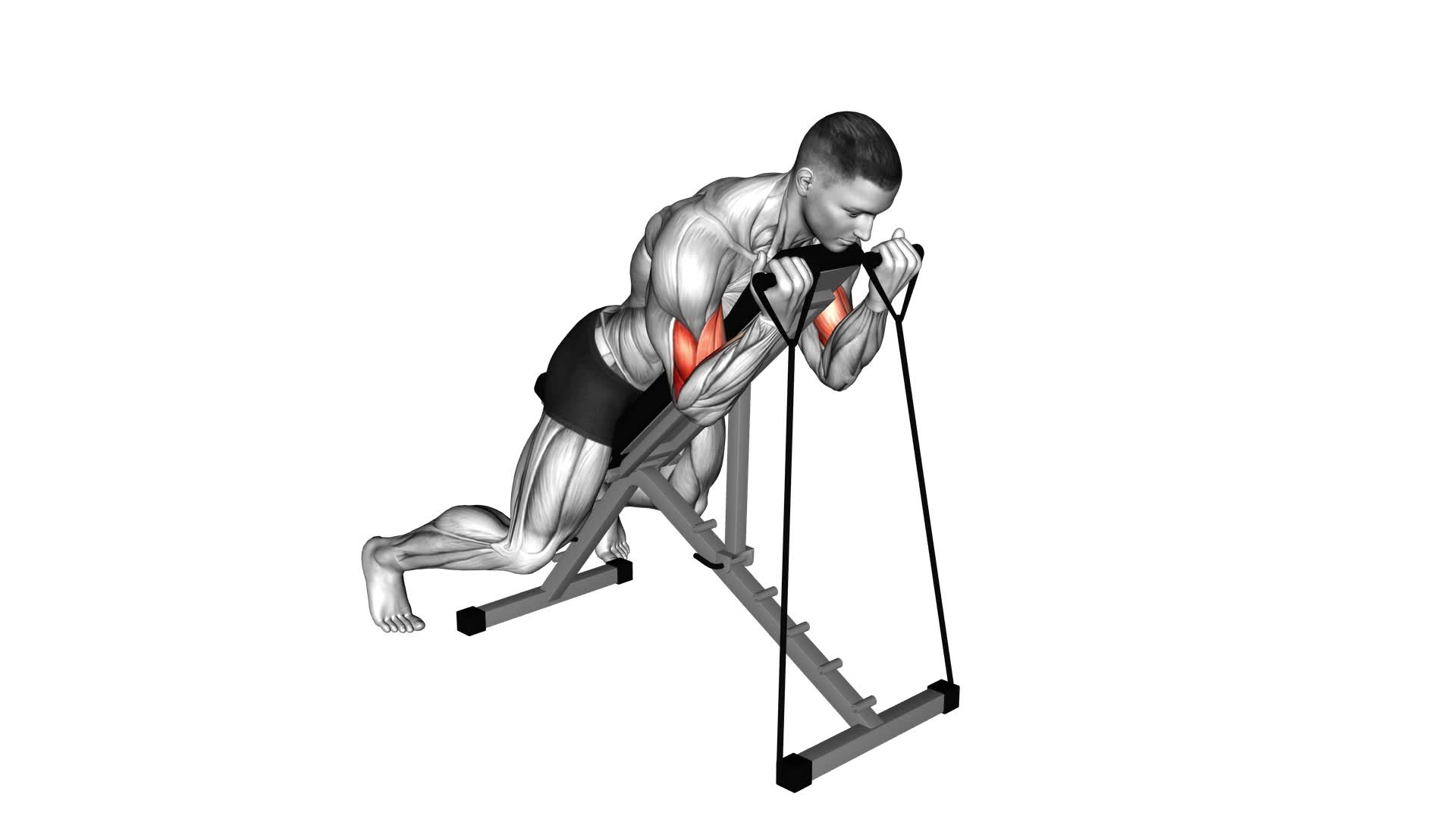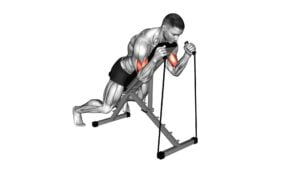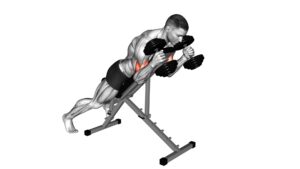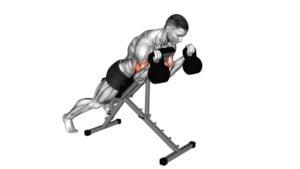Band Prone Incline Curl – Video Exercise Guide & Tips

Looking to tone and strengthen your arms? The Band Prone Incline Curl is the perfect exercise for you. In this video exercise guide, we'll show you the proper form and technique to maximize your results.
Watch This Exercise Video
Whether you're a beginner or an advanced fitness enthusiast, we've got you covered with variations and modifications to suit your fitness level. Get ready to take your arm workout to the next level with the Band Prone Incline Curl.
Let's get started!
Key Takeaways
- The band prone incline curl is a highly effective exercise for strengthening the upper body.
- It targets the biceps and forearms, resulting in lean and defined muscles.
- The exercise also engages the shoulders and upper back, contributing to overall upper body strength.
- It is important to maintain proper form and technique, such as avoiding shoulder shrugging and keeping the shoulders down and back throughout the exercise.
Benefits of the Band Prone Incline Curl
Experience the numerous benefits of the Band Prone Incline Curl, a highly effective exercise for strengthening your upper body. This exercise primarily targets your biceps and forearms, helping you develop lean and defined muscles in these areas. The Band Prone Incline Curl also engages your shoulders and upper back, promoting overall upper body strength and stability.
One of the key benefits of this exercise is its ability to activate and isolate the biceps muscles. By using resistance bands, you can adjust the tension according to your fitness level, making it suitable for beginners and advanced individuals alike. The constant tension provided by the bands also ensures that your muscles are fully engaged throughout the entire range of motion, maximizing muscle activation and growth.
Another advantage of the Band Prone Incline Curl is its versatility. You can easily modify the exercise by changing the incline angle or using different variations of resistance bands. Altering the incline angle allows you to target different areas of the biceps, providing a well-rounded workout for your upper arms. Furthermore, using different types of resistance bands offers varying levels of resistance, allowing you to gradually increase the challenge as your strength improves.
Equipment Needed for the Exercise
To perform the Band Prone Incline Curl, you'll need specific equipment to maximize the effectiveness of the exercise. This exercise requires an incline bench and resistance bands. The incline bench is essential for targeting the biceps and ensuring proper form throughout the movement. It allows you to lie face down with your arms extended, providing a stable base for the exercise. The resistance bands are used to add resistance to the curling motion, challenging your biceps muscles and promoting muscle growth.
When choosing resistance bands, it's important to select ones that are suitable for your fitness level. Bands come in different colors, indicating different levels of resistance. Beginners may want to start with lighter bands and gradually increase resistance as they become stronger. Additionally, it's recommended to use bands with handles for a more comfortable and secure grip.
While the Band Prone Incline Curl specifically requires an incline bench and resistance bands, there are alternative equipment options for similar exercises. If you don't have access to an incline bench, you can use a stability ball or a flat bench as substitutes. As for resistance bands, dumbbells or barbells can be used instead to perform similar curling exercises.
It's important to consult with a fitness professional to ensure proper form and technique when using alternative equipment for different exercises.
Proper Form and Technique for the Band Prone Incline Curl
To perform the band prone incline curl with proper form and technique, it's important to avoid shoulder shrugging and engage your core muscles.
Shoulder shrugging can put unnecessary strain on your neck and shoulders, so focus on keeping them relaxed and stable throughout the exercise.
Engaging your core muscles will help maintain proper alignment and stability, ensuring a more effective and safe workout.
Avoiding Shoulder Shrugging
To avoid shoulder shrugging during the Band Prone Incline Curl, focus on keeping your shoulders down and back. Maintaining proper shoulder stability and posture is crucial for performing this exercise effectively and minimizing the risk of injury.
Here are four key tips to help you achieve the correct form:
- Start by lying face down on an incline bench, with your chest supported and your feet firmly on the ground.
- Grip the resistance band handles with your palms facing up, and keep your elbows tucked in close to your sides.
- As you curl the bands towards your shoulders, concentrate on keeping your shoulders relaxed and down, away from your ears.
- Avoid any upward movement or hunching of the shoulders throughout the exercise, maintaining a stable and controlled motion.
Engaging Core Muscles
You should regularly engage your core muscles to maintain proper form and technique during the Band Prone Incline Curl. Engaging your core muscles not only helps in strengthening your abs but also plays a crucial role in improving your overall posture.
When performing the Band Prone Incline Curl, focus on contracting your abdominal muscles by pulling your belly button towards your spine. This will help stabilize your torso and prevent any excessive arching or rounding of your back.
Common Mistakes to Avoid During the Exercise
When performing the band prone incline curl, be mindful of two common mistakes:
- Allowing your elbows to move too far forward and
- Gripping the band too tightly.
Keeping your elbows in line with your body ensures proper form and targets the correct muscles. Additionally, avoid gripping the band too tightly as this can create unnecessary tension and restrict your range of motion.
Elbows Too Far Forward
Correct elbow positioning is crucial during the Band Prone Incline Curl exercise to prevent the elbows from extending too far forward. When your elbows are too far forward, it can lead to improper alignment and reduce bicep activation. To ensure proper elbow positioning, follow these tips:
- Maintain a stable bench: Make sure the bench is set at a comfortable incline angle to support your upper body and provide stability.
- Keep elbows close to your sides: Throughout the movement, keep your elbows close to your body to maintain proper alignment and prevent them from extending too far forward.
- Engage your core: Activate your core muscles to stabilize your body and prevent excessive movement of the elbows.
- Focus on the squeeze: When curling the bands towards your shoulders, focus on squeezing your biceps at the top of the movement to maximize bicep activation.
Gripping Too Tightly
One common mistake to avoid during the Band Prone Incline Curl exercise is gripping the bands too tightly. While it may seem natural to hold on tightly for added stability, gripping the bands too tightly can actually hinder your performance and lead to hand fatigue.
It's important to find a balance in your grip strength to ensure optimal results. By maintaining a moderate grip, you can engage the targeted muscles effectively without straining your hands. Additionally, gripping the bands too tightly can limit blood flow to your hands, causing discomfort and potentially affecting your performance.
To improve grip strength and prevent hand fatigue, consider incorporating exercises specifically targeted towards strengthening your hands and forearms, such as wrist curls and farmer's walks.
Variations and Modifications for Different Fitness Levels
To modify the band prone incline curl for different fitness levels, you can incorporate variations that target specific muscle groups. Here are four variations and progressions you can try:
- Single Arm Band Prone Incline Curl: Instead of using both arms simultaneously, perform the exercise with one arm at a time. This variation allows you to focus on each arm individually and increases the resistance on the working arm.
- Resistance Band Prone Incline Hammer Curl: Change your grip from an underhand grip to a neutral grip, with your palms facing each other. This variation shifts the emphasis from the biceps to the brachialis and brachioradialis muscles in the forearm.
- Band Prone Incline Reverse Curl: Start with an underhand grip, but instead of curling the band towards your shoulders, curl it towards your hips. This variation targets the brachialis muscle and emphasizes the brachioradialis muscle in the forearm.
- Band Prone Incline Curl with Isometric Hold: After curling the band towards your shoulders, hold the contraction at the top for a few seconds before releasing. This progression increases the time under tension and enhances muscle activation.
Tips for Incorporating the Band Prone Incline Curl Into Your Arm Workout Routine
To effectively incorporate the band prone incline curl into your arm workout routine, consider the following tips.
First, make sure to have resistance bands that are appropriate for your fitness level. Resistance bands come in different levels of tension, so choose one that challenges your biceps and upper back muscles without causing strain or discomfort.
Before starting the exercise, set up an incline bench at a 45-degree angle and securely attach the resistance band to the base of the bench. Lie face down on the bench, with your chest resting against the incline and your arms extended towards the floor, holding the resistance band with an underhand grip.
When performing the band prone incline curl, focus on maintaining proper form. Keep your elbows close to your sides, and slowly bend your arms at the elbow, bringing your hands towards your shoulders while keeping your upper arms stationary. Pause at the top of the movement and then slowly lower the resistance band back to the starting position.
To maximize the effectiveness of this exercise, aim for controlled and deliberate movements. Perform the recommended number of repetitions and sets as part of your overall arm workout routine.
Frequently Asked Questions
How Many Reps and Sets Should I Do for the Band Prone Incline Curl?
To get the most out of the band prone incline curl, it's important to know how many reps and sets to do. Proper form is crucial for this exercise, so start with a weight that challenges you but allows you to maintain good technique.
Aim for 3-4 sets of 8-12 reps, resting for 60-90 seconds between sets.
Can I Use a Different Type of Resistance Band for This Exercise?
Yes, you can use a different type of resistance band for the band prone incline curl. There are various types of resistance bands available, such as loop bands, tube bands, and flat bands. Each type offers different levels of resistance.
If you don't have a resistance band, you can also try alternative exercises like dumbbell curls or cable curls to target the same muscle group.
Remember to choose a resistance level that challenges you but allows you to maintain proper form.
Is the Band Prone Incline Curl Suitable for Beginners?
Yes, the band prone incline curl is suitable for beginners. It's a great exercise to target your biceps and build strength.
For reps and sets, start with 2-3 sets of 8-12 reps, focusing on maintaining proper form throughout.
You can use a different type of resistance band as long as it provides enough resistance. However, make sure to choose a band that suits your current fitness level.
If you have a shoulder injury, it's best to consult with a healthcare professional before attempting this exercise.
Rest for about 1-2 minutes between sets to allow your muscles to recover.
Can I Do the Band Prone Incline Curl if I Have a Shoulder Injury?
If you have a shoulder injury, it's important to modify the band prone incline curl exercise. This exercise can be beneficial for shoulder rehabilitation, but you should consult with a healthcare professional or a qualified trainer for proper modifications.
They can provide you with alternative exercises that will help strengthen your shoulder without causing further injury. It's crucial to prioritize your recovery and avoid any movements that could worsen your condition.
How Long Should I Rest Between Sets for This Exercise?
For optimal results, it's important to rest between sets when performing any exercise, including the Band Prone Incline Curl.
Rest periods allow your muscles to recover and replenish energy. The ideal rest time for this exercise is around 1-2 minutes.
However, it's important to listen to your body and adjust the rest periods based on your fitness level and how you feel.
Conclusion
Incorporating the band prone incline curl into your arm workout routine can help strengthen and tone your biceps. This exercise targets the muscles in your upper arms, providing a challenging and effective way to build strength.
By using proper form and technique, you can maximize the benefits of this exercise while avoiding common mistakes. Whether you're a beginner or advanced fitness enthusiast, there are variations and modifications available to suit your fitness level.
So grab a resistance band and get ready to sculpt those arms!

Author
Years ago, the spark of my life’s passion ignited in my mind the moment I stepped into the local gym for the first time. The inaugural bead of perspiration, the initial endeavor, the very first surge of endorphins, and a sense of pride that washed over me post-workout marked the beginning of my deep-seated interest in strength sports, fitness, and sports nutrition. This very curiosity blossomed rapidly into a profound fascination, propelling me to earn a Master’s degree in Physical Education from the Academy of Physical Education in Krakow, followed by a Sports Manager diploma from the Jagiellonian University. My journey of growth led me to gain more specialized qualifications, such as being a certified personal trainer with a focus on sports dietetics, a lifeguard, and an instructor for wellness and corrective gymnastics. Theoretical knowledge paired seamlessly with practical experience, reinforcing my belief that the transformation of individuals under my guidance was also a reflection of my personal growth. This belief holds true even today. Each day, I strive to push the boundaries and explore new realms. These realms gently elevate me to greater heights. The unique combination of passion for my field and the continuous quest for growth fuels my drive to break new ground.







